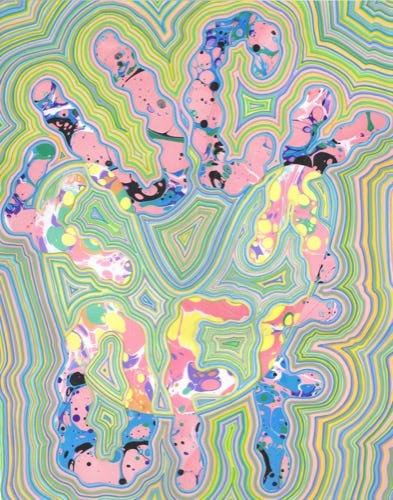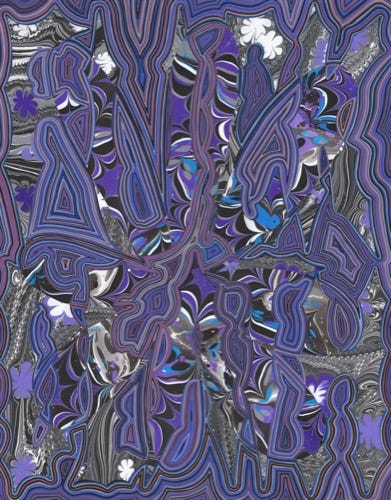Fricatives and Plosives
40 Ways to Say Fuck, A Micro-Canon of Chinese Cinema, & The Great Shanghai Daft Punk Scam
40 Ways to Say Fuck
The images in this issue come from the wonderful Alice Lang, an Australian artist based in Los Angeles. In 2020, Alice began a series of paintings riffing on the infinite combinations of the ultimate four-letter word, deceptively chill in their psychedelic marbling but containing a crystallized outrage. Or at least that’s how they feel to me, echoing the ambient sentiments (and frequently *literal* groans, shrieks, cries) of this past year, and each new piece of heartrending news hitting the timeline. Fuck this, fuck that, fuck off. Fuck death most of all.
The pieces are also just, funny, which is always an underrated aesthetic quality. I loved seeing this series evolve over the past year via Instagram, popping up occasionally to punctuate the scroll, each one a silent colorful curse. Here are a few of my favorites, and for those in L.A., the full set of “40 Ways to Say Fuck” appears in Alice’s new exhibition “Cool Story Bro”, up until March 31 at AFP gallery in Los Angeles (dm the gallery to make an appointment).
100 Films To Understand China
Way back in the ancient past of January 2020, friends at the digital publication Radii China asked several China filmmakers, scholars, critics and curators to weigh in on a deliberately impossible question: What are 100 films to understand China? Not the 100 best, or most important, and certainly not in any order, but what are 100 films that could serve as an introductory cross-section of China’s current and historical complexity? For simplicity’s sake, we were asked to only focus on films made in a Mainland Chinese context - excluding the industries of Hong Kong and Taiwan, because, uh, the list would otherwise be at least 500 films long. I was honored to chime in with a few of my all-time favorites to this sprawling list that finally came out last month, which is helpfully divided into 10 roughly chronological categories (Pre-War, the Mao Years, Opening Up, Arthouse, Documentary, Wuxia, Pop(corn), China Today, Bad Films, Animation).
Read the whole list here, and see my particular picks below with brief summaries; many of these are available through streaming sites online! (The main one that I would encourage you to see someday safely in a theatre, in its full 3D glory, is “Long Day’s Journey into Night”)
West of the Tracks (Wang Bing, 2002) - West of the Tracks documents social changes wrought by urbanization & “opening up” with a pace that’s somehow simultaneously brutally fast and painfully slow
San Yuan Li (Ou Ning, Cao Fei, 2003) - An experimental film by two of Guangdong’s most influential contemporary artists, Ou Ning and Cao Fei, San Yuan Li focuses on life in a traditional village beset by the spread of urban centers.
Oxhide (Liu Jiayin, 2005) - Filmed when director Liu Jiayin was just 23 years old, this familial movie takes Liu’s family as its main focus, depicting their daily lives within an impossibly small apartment. The film takes a seemingly mundane topic and transforms it into something huge, and emphasizes the possibilities of film on a tiny budget.
The Panda Candy (Peng Lei, 2007) -Directed by the frontman of legendary Chinese rock band, New Pants, The Panda Candy depicts rebellious youth and lesbian love, set in karaoke bars and concerts with the lead in the film on tour with her friend’s band, The Panda Candy is at once an ode to youth, to music and to sexual longing.
China Concerto (Wang Bo, 2012) - An arthouse film in the classic sense, screening at a variety of museums and auditoriums, Wang Bo’s China Concerto is framed as an essay, a theoretical and elucidating dive into culture, showmanship and spectacle in a modern China that refuses to compromise its uniqueness.
Old Dog (Pema Tseden, 2011) - Set in the Tibet Autonomous Region, Pema Tseden’s Old Dog depicts the conflict between commerce and emotion, with the country’s burgeoning trade industry for mastiff dogs the backdrop.
Long Day’s Journey Into Night (Bi Gan, 2018) - The director of Long Day’s Journey Into Night, Bi Gan, might be the most experimental and interesting director in China today. My rambling endorsement: “This is the first 3D film I have ever cared about, and could be the last — it will be near impossible for anything to top it. Yes, its characterization is thin and opening half is molasses-slow — but that’s ultimately all on purpose, lulling the audience into a near-REM state to be prepared for the second half, a 59-minute unbroken single take filmed in 3D that floats through and around a nighttime village in ruins as a noir-ish antihero searches for a mysterious woman. Besides being technically brilliant, the sequence may capture the dislocated experience of late 2010’s reality (in China and elsewhere) better than any other — the suspended logic of a dream.”
The Great Shanghai Daft Punk Scam
Daft Punk broke up!
"How good were they? Almost impossibly. Is this breakup a stunt? Hopefully. Were they scammers? In a way, though only in the tradition of popular music’s cannibal contract."
I liked this elegy to the duo by Sasha Frere-Jones quoted above, and that particular line brought to mind something that, unless you lived in China in 2009, you may not be aware of. That is, of course, the Great Shanghai Daft Punk Scam.
On February 8, 2009, I was living in Beijing and a Shanghai friend emailed me with the exhortation, “if this is for real, COME!!!” and a link to a short-lived website: http://www.dafthidden.com, which with shiny chrome accents presented an irresistible idea: Daft Punk would be playing a secret show in Shanghai in a week’s time! The warehouse venue would only be revealed the morning of by text message to avoid being shut down by authorities (which was a frequent risk for concerts at the time). Tickets were a cool 500 RMB (appx 80 USD), which was outrageously high, and so obviously targeting primarily expats and wealthier music nerds/party kids. It was certainly outside my budget so I told my friend I would have to decline. As the days until the concert ticked by, and more people went to a pop-up event office to pay for their tickets in cold hard cash, rumors started to circulate that maybe it wasn’t real. By the time the French robots would have been theoretically hitting the stage, it was clear that two (also French?) scam artists had bilked Shanghai’s (heavily French!) expat community for perhaps hundreds of thousands of US dollars. And then disappeared forever. While I have some local friends who also got scammed, I can’t help but understand the broader schadenfreude (and hilarity) of this story, with its extra dose of postcolonial frisson. To relive the whole thing, read this contemporaneous account on the local website SmartShanghai, which even contains the classic post-scam scene where the reporter shows up to where they were selling tickets days earlier - and it’s now just an empty shell:
“The author accused them of setting up a hoax, they got into a fight and the call ended. On Tuesday morning he got a text message to go to the office for a meeting at 11am.
He showed up, no one was there, and the money was gone.”
Adieu, Shanghai Daft Punk scammers, and now, 12 years later, adieu Daft Punk!
Listening
🎧 Los Brincos “Contrabando”, 1968 - I only just discovered this 1960s Spanish garage rock group and their handclappy “Contrabando” is what I have been looping… listen on Youtube, incredible original album art below. Sidenote: what do you call *this style* of line drawing/aesthetic? I’m lately fascinated by late 1960s/1970s “retro” kitsch that riffs on 1930s Hollywood/deco. As far as I can tell, this is a sub-category that is yet unexplored in Aesthetics Wiki or the stunning research that CARI - “Consumer Aesthetics Research Institute” is compiling. More broadly, I’m interested what we could call “sedimental retro” (sentimental sediment?) or “meta vintage”, ie how earlier time-capsules of a “retro” interpretation gradually layer and/or filter through to our own era. If you have more thoughts or reading recs on this, please let me know!
Reading
“Why Chinese artists are moving to the countryside”: There is much more to say about the “neo-rural” movement in China, but start with this textured introduction by my friend Jacob Dreyer that explores the term “neijuan” and the inward turn in Chinese culture right now:
The Chinese Internet started discussing the agricultural term neijuan (内卷) as a metaphor for life in the country—the phrase literally means ‘rolling inside’, like a person trapped in a barrel, their energies prevented from being released into the outside world.
The just-launched newsletter “Chaoyang Trap House” was an automatic subscribe for me - a new collaborative publication by many China writers/artists I admire, billed as “a lit/based China newsletter for hot/cringe times”. Apparently the first few issues will cover keywords like “China’s First Listener,” “Rich Kids English Police,” “Luo Xiang Detective Club,” “Ryuichi Sakamoto Cringe,” “Advanced Lesbianism,” and the “Cold Showers Blockchain.”
The epic crossover event of Ingrid Burrington interviewing Keller Easterling - two voices I value very much on large-scale system thinking and infrastructure (but so much more than that). Read the dialogue and then consider getting Easterling’s great new book Medium Design. Particularly love this:
IB: […] this is the problem in trying to talk about the book—I’m sort of expected to say, “Keller Easterling says this is the way forward,” or something, and it’s really written in opposition to that whole idea of the singular great idea or perfect certainty.
KE: The book is trying to expose a kind of ideational monotheism for which we’re still hardwired. The assumption is that the author will unleash a radical new idea that kills the father and replaces everything else. Even when you don’t do that, they will say you did, and they will always use the word “radical.” But I am trying to find a trapdoor out of that habit of mind…A tribute to the globally beloved, only-vaguely-named “super soft blanket” or “flower blanket”, lushly photographed by Farah Al Qasimi… this made me instantly nostalgic for freezing winter nights in some random Changsha or Nanjing hotel where the bristly kiss of this blanket was the one thing keeping out the chill
The latest volume of “Orange Crush: The Journal of Art & Wrestling”, which just arrived in its full print beauty; check out their splashy virtual “table” at the most recent Printed Matter Art Book Fair, and a CNN article about the inspirations for the project. I particularly loved the interview of Mike Watt / Raymond Pettibon by editor Hunter Braithwaite
Haley Mlotek on “the queer art of divorce” in conversation with Torrey Peters and Ethan Philbrick.
“EP: Marriage is often thought of as a ritual for creating something new, for instituting a new family, but for so many people it’s a consolidation of continuity[…]”“Who didn’t want to scream for much of 2020?” Jace Clayton in e-flux on collective screaming, catharsis, and an excellent video by artist Meriem Bennani
Best fucking wishes (but truly),
x shc







